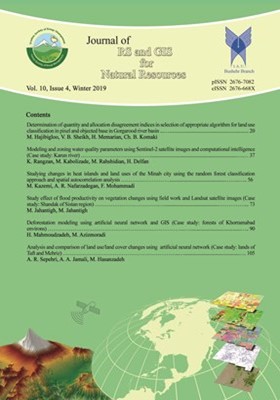Studying changes in heat islands and land uses of the Minab city using the random forest classification approach and spatial autocorrelation analysis
Subject Areas : Geospatial systems developmentMohamad Kazemi 1 , Ali Reza Nafarzadegan 2 , Fariborz Mohammadi 3
1 - Assist. Prof. Hormoz Research Center, University of Hormozgan, Iran
2 - Assist. Prof. Hormoz Research Center, University of Hormozgan ;
Assist. Prof. Department of Natural Resources Engineering, Faculty of Agriculture and Natural Resources, University of Hormozgan, Iran
3 - Assist. Prof. Hormoz Research Center, University of Hormozgan ;
Assist. Prof. Department of Water Sciences & Engineering, Minab Higher Education Center, University of Hormozgan, Iran
Keywords: spatial autocorrelation, Urban heat island, land use changes, Random forest,
Abstract :
The purpose of this study was to assess the impact of the land use changes in the Minab city on the variations in the urban heat islands (UHI), using the random forest classification method and spatial statistics on TM and OLI Landsat images in 1988, 1998, 2008 and 2018. First, land surface temperature (LST) was calculated using the split-window and the single-channel algorithms. Land use map was generated using supervised classification random forest method and its performance was assessed by two criteria of overall accuracy and kappa coefficient. In order to survey spatial autocorrelation and clustering, pattern of hot spots, the two statistics of Anselin Local Moran's I and Getis-Ord GI were applied. In 1988, land uses of vegetated, barren, and urban built-up lands were occupied 30.1, 32.53 and 37.37 percent of the city area, respectively; in 2018, the areas of these land uses were 16.36, 9.56 and 74.08 percents, respectively. A threefold and twice-fold decrease in the area was observed for barren and vegetated lands, respectively; while the area of urban built-up lands had more than doubled. The calculated values for urban-heat-island ratio index (URI) in 1988, 1998, 2008, and 2018 were 0.45, 0.34, 0.11, and 0.22, respectively. The outcomes of two considered spatial statistics indicated the clustering, pattern for UHI of the Minab city. In addition, there was a good agreement between the results of Getis-Ord GI statistic (hotspots spatial analysis) and the Local Moran's I statistic (spatial autocorrelation) on the spatial pattern of heat and cool clusters.
_||_


